Third Officer Herbert Pitman
- Career at Sea
On Day 4 of the United States Inquiry into the Titanic disaster in Washington, Pitman summarised his sea career:
Senator SMITH. How long have you been engaged in marine employment?
Mr. PITMAN. About 17 years... Four years with James Nourse (Ltd.), as an apprentice; three years as all officer in the same employ; about twelve months in the Blue Anchor Line, running to Australia; six months in the Shire Line, running to Japan; and five years with the White Star.
Senator SMITH. In what capacity did you serve with the White Star?
Mr. PITMAN. Second, third, and fourth officer; second officer for two months.
Senator SMITH. On what vessels of the White Star Line have you served?
Mr. PITMAN. On the Dolphin, the Majestic, and the Oceanic.
The following is a detailed examination of the specific qualifications and ships he served on.
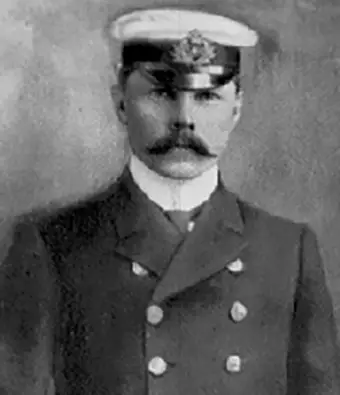
An undated photograph of officer Pitman.
Forth and Second Mate Certification
When his four year apprenticeship with James Nourse Ltd ended on the 18th of April 1899 he was firstly employed as an officer aboard the same company's sailing ship, Forth, as third mate, from the 2nd of May 1899 until the 20th of January 1900 - a length of 8 months and 19 days. The Forth was one of the ships he had served his apprenticeship on.
On the 10th of April 1900, Pitman applied for his second mate certificate in the port of Bristol, which was the closest port to his place of residence at the time, at Sandbrook, Galhampton Bath (Yeovil). Unfortunately he failed on the subject of navigation, and reapplied on the 17th of April 1900 to fail once again on navigation. He finally passed on the 7th of May 1900, with his second mate certificate issued 7 days later on the 14th of May 1900.
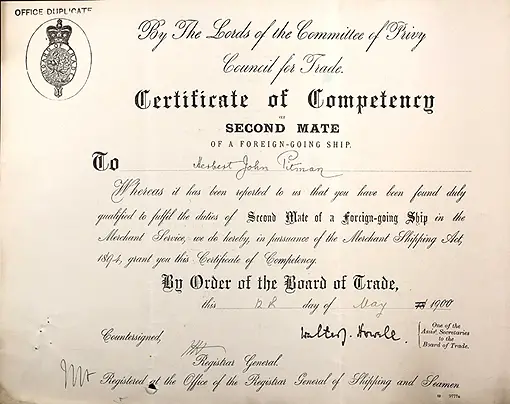
Pitman's second mate certificate, which he passed on the 14th of May 1900.
(Click image to enlarge)
Clyde and First Mate Certification
Continuing at first as the third officer, Pitman worked aboard the James Nourse ship Clyde, for six months and 12 days from the 11th of August 1900. On the 22nd of February 1901 he was then promoted to second officer and served aboard the Clyde for another year, 1 month and 17 days until the 8th of April 1902.
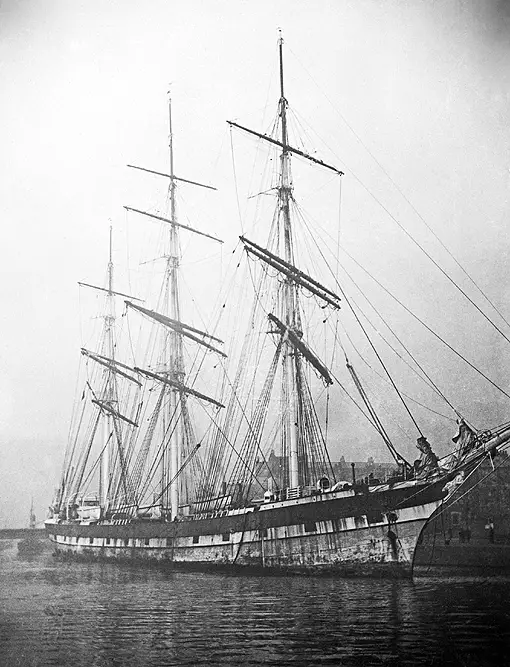
Built in 1894, the Clyde was a steel three masted ship, 1813 grt/1654 nrt, 270.9 ft long, 39ft wide and 22.5 deep. Image: clydeships.co.uk
(Click image to enlarge)
Back in the port of Bristol, Pitman applied for his first mate certificate on the 9th of June 1902 and passed on first attempt, with the certificate issued on the 19th of June, 1902.
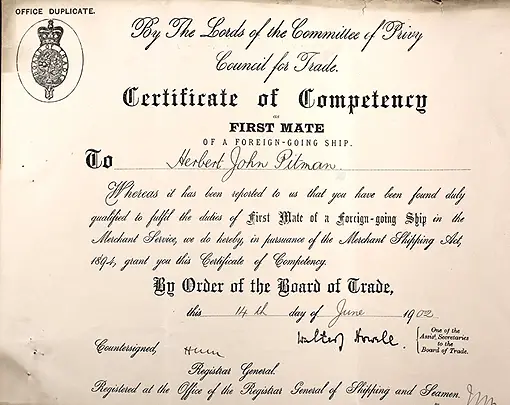
Pitman's first mate certificate, which he passed on first attempt on the 9th of June 1902.
(Click image to enlarge)
Pitman's time at the Norse Line did ensure he got to see the world - the good and the bad:
There were calls at Calcutta, the thriving, fly-ridden port where the smell of betel-nut and curried rice, the clamour of merchants and boys hit the senses for the first time but gradually emerge as being a cameo of the East. From Calcutta his ship used to take emigrants to the West Indies. From Liverpool, particularly, and from other ports in the United Kingdom the vessels would sail with a ballast of salt, more precious than gold dust. Some weeks later they would be crossing the line west of Africa and at 16 degrees south would pass the Isle of St. Helena where Napoleon spent his exile. From the South Atlantic, the ship would round the Cape of Good Hope and steer nor’-east to India, the land of prosperous princes and abject poverty.(Central Somerset Gazette, 27th August 1954)
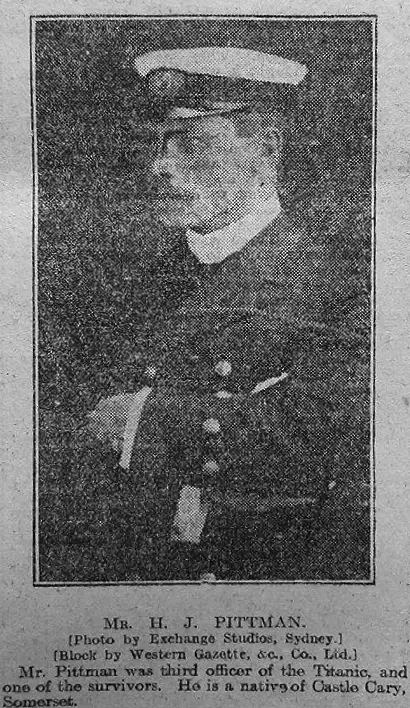
A newspaper photograph (undated) of Third Officer Pittman [sic]. The photograph was taken by the "Exchange Studios, Sydney" so must be during his year with the Blue Anchor Line on the Australia run, perhaps the SS Warrigal, aboard which he was third officer, 23rd of September 1902 and 6th of July 1903.
(Courtesy of Paul Lee/The Somerset County Herald of 27/4/12).
Steam Ships
After seven years with James Nourse he made the jump from sailing ships to steam and joined the Blue Anchor Line which operated between the UK and Australia. His first steam ship was the SS Warrigal, aboard which he was back to being third officer for 8 months between the 23rd of September 1902 and 6th of July 1903 sailing to Australia.
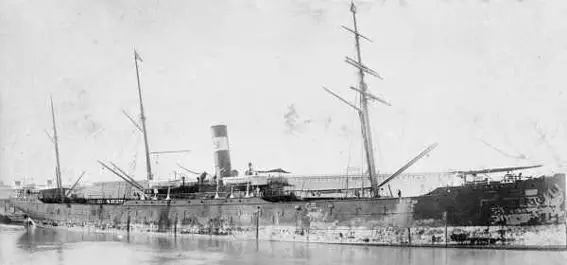
Built in 1893 the SS Warrigal was a steel single screw steamer for passengers and cargo, 4387grt/2778nrt, 400.0 ft long, 47.6 ft wide and 26.6ft deep. In 1908 it sank after a collision with the S.S. Japanic off Wolf L.H. on passage from Montreal to London.
Possibly frustrated with not moving up from third officer he switched to the Shire Line, with whom he served for six months, 7th October 1903 - 19th April 1904, still as third officer, aboard the SS Denbighshire which sailed to Japan. Built in 1899 the Denbighshire was a 356 foot long single screw steamer.
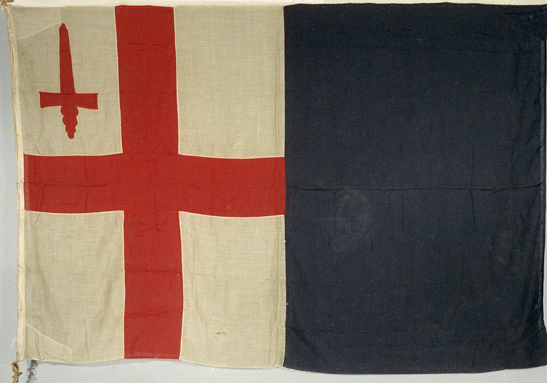
Shire Line house flag.
(National Maritime Museum, Greenwich, London, Daniel Bolt Collection).
SS Indus and Promotion
He subsequently returned to where he had started by rejoining the Nourse Line, this time serving aboard its new 3,393-ton steamship the SS Indus. Built by Charles Connell & Company Limited, Glasgow she had a single screw, triple expansion, 425 nhp engine and was launched on the 28th of April 1904 and delivered to the Norse Line in May 1904. Pitman served as third officer and then second officer for 7 months and 7 days from the 2nd of July 1904 until the 9th of February 1905, during which time the ship travelled to Trinidad and was primarily used for the transportation of Indian indentured labourers to the colonies.
Pitman was then promoted to first officer and worked aboard the SS Indus from the 10th of January 1905 until the 28th of August 1905 - a total of 6 months and 19 days, followed by another 9 months and 21 days as first mate from the 13th of September 1905 until the 3rd of July 1906.
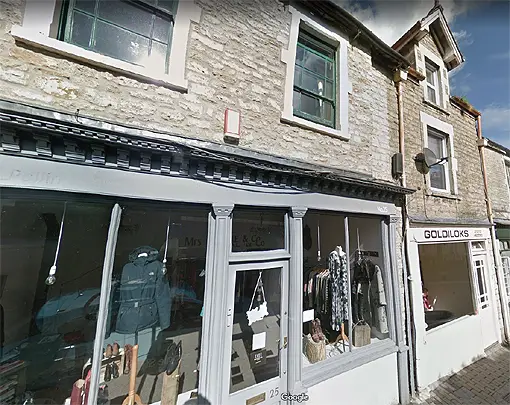
25 Catherine Street, Frome as it looks today, the address Pitman gave when sitting for his Master's Certificate. Frome is about 25 miles south east from Bristol and about the same distance north of Sutton Montis where he grew up (Google Streetview).
Master's Certificate and White Star Line
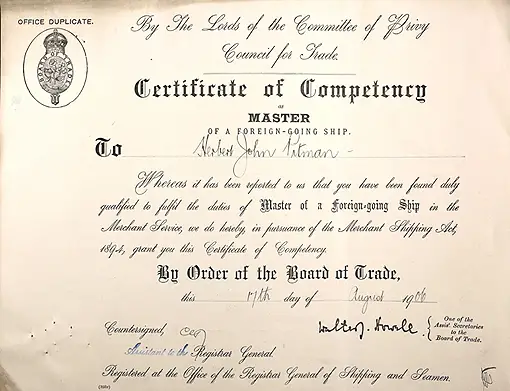
Pitman's Master certificate, which he passed on the 14th of August 1906.
(Click image to enlarge)
In August 1906 he returned to his home port of Bristol and on the 14th applied successfully for his Master's Certificate, with his address listed as 25 Catherine Street, Frome.
With a Master's Certificate under his belt, he joined the prestigious White Star Line on the 19th of April 1907 (according to his White Star Line record), receiving his first posting until May, to the ocean liner the SS Gothic aboard which he served for 5 months, from May 1907 until the 14th of September 1907, as third officer on the New Zealand run. From a hand written postcard that appeared at an auction at Henry Aldridge & Son in June 2020, it seems he visited Queenstown, New Zealand in June 1907.
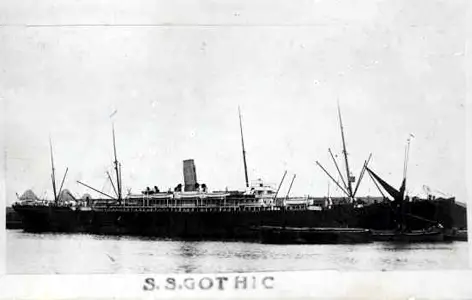
The SS Gothic was Pitman's first White Star Line steamer he worked aboard.
The SS Gothic was built in 1893 at the Harland and Wolff Shipyards for the White Star Line and was 490 ft long and 53 ft wide and 7755 gross registered tons. The Gothic caught fire in June 1906, the year before Pitman served aboard her and was subsequently repaired. Following Pitman's time aboard in 1907, she was converted into an immigrant ship and chartered to the Red Star Line and renamed as the SS Gothland.
From the 14th of September 1907 until March 1911 Pitman served aboard the SS Delphic, as both third officer (White Star Line records: 14.8.07 - 5.10.07, 5.10.07 - 26.12.07, 15.5.08 - 5.3.11) and then second officer (White Star Line records: 26.12.07 - 15.5.08, 5.3.11 - 18.3.11) - the highest rank he would ultimately achieve as an officer in the White Star line.
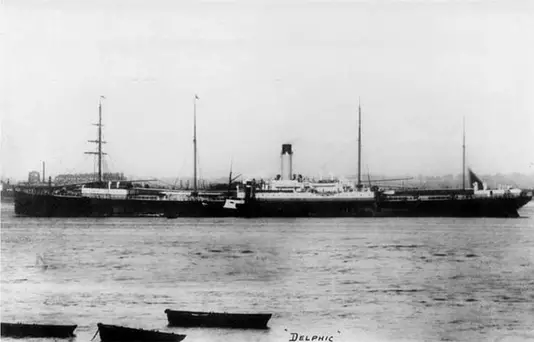
The SS Delphic was Pitman's second White Star Line steamer he worked aboard.
SS Delphic was also built by Harland and Wolff in Belfast and completed on 15 May 1897. She worked the New Zealand trade. In design Delphic was built as a smaller and slower version of the earlier liner Gothic which also served the New Zealand service, but more space had been given over to passenger accommodation rather than cargo, and this gave Delphic a capacity for 1,000 steerage passengers. She was built for a joint service between White Star Line and the Shaw, Savill & Albion Line.
In March 1911, Pitman moved to a slightly older but larger ship - the SS Majestic, serving aboard her in the role of Fourth officer from the 22nd of March 1911 to the 28th of June 1911, as well as 15th of July 1911 through to the 22nd of August 1911 (White Star Line records). At first glance it may look like a demotion to an older ship - however he was now working on the North Atlantic run from Southampton to New York run, which the Majestic had been sailing since 1907.
Captain Smith had been captain of the Majestic in 1895: at the time she was one of White Star's finest ships, weighing 9,965 tons and 582-feet in length, with two triple expansion engines powering two propellers meaning the ship was capable of 20 knots. It also had capacity for 1490 passengers. Shortly after Pitman's tenure which ended in August 1911, Charles Herbert Lightoller joined Majestic as her first - and temporarily chief - officer from December 1911 to March 1912.
_small.jpg)
The White Star Line's S.S. Majestic, where Pitman served as fourth officer from March to August 1911. (Click to enlarge)
On the 4th of August 1911 (his White Star Line record states the 22nd of August 1911) Pitman joined the S.S. Oceanic, once again in the role of Fourth officer, but now on an even more prestigious ship. Launched in 1899, she was the largest ship in the world until 1901 and at 17,272 gross tonnes was 704 ft (215 m) long and 68.4 ft (20.8 m) wide, powered by triple expansion reciprocating engines equalling 28,000 horsepower. Lightoller had served aboard the Oceanic from 1907 to 1911, beginning as Second officer and then moving on to First, and spoke very highly of the ship:
“I got my severest mail boat training during the seven hard, though happy years I spent in the Queen of the Seas, as the Oceanic was then called. A wonderful ship, built in a class of her own, and by herself... She was an experiment, and a wonderfully successful one; built by Harland and Wolff, regardless of cost, elaborate to a degree, money lavished where it was necessary, but never gaudily as is so common nowadays.”(47.)
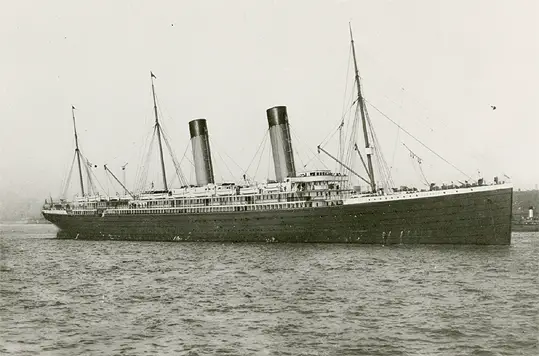
On the 4th of August 1911 Pitman joined the S.S. Oceanic, in the role of Fourth officer. (Click image to enlarge)
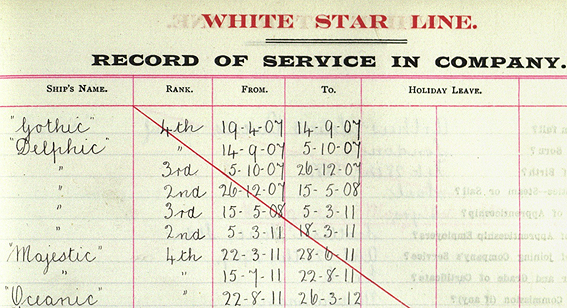
Pitman's White Star Line record detailing the ships he worked on prior to the Titanic.
While Pitman did not serve aboard the Olympic during 1911, he had in his possession a photograph of his fellow officers in their summer whites from this year - which not only reveals that he knew many of them but it also helped with the identification of officers in other photographs. Author George Behe explains:
The key item which finally established the definite identities of the men in the 'nine-officer photo' was Pitman's copy of a photograph of thirteen White Star officers dressed in summer white uniforms (see below). Without ever realizing the importance of his having done so, Mr. Pitman labeled his photograph with the names of twelve of the thirteen officers who were pictured in the photograph. The present author had glanced at this photo in 1993 and set then it aside without examining it with the care it deserved. It was only in late February of the year 2000 that I took another look at Pitman's photo and realized the importance of the information it contained; all of the officers pictured in the 'nine- officer photo' were also present in Pitman's photo of thirteen officers -- and all were identified by notations in Pitman's own hand. (A Mystery Solved - Identifying Titanic's Officers, by George Behe. Check article here. )
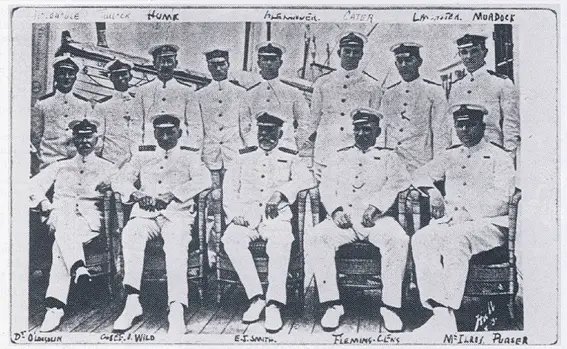
This photograph belonged to Herbert Pitman and his handwritten notations identified the thirteen officers. Standing: Holehouse, Tulloch, Hume, Alexander, Cater, Lancaster, Murdoch. Sitting: Dr. O'Loughlin, Chief H. Wilde, E. J. Smith, Flemming - Chief Eng., McElroy - Purser. Courtesy Onslows. (Click image to enlarge)
Pitman's rise in White Star was about to take another step: in March 1912, at the age of 34, he was appointed to the maiden voyage of the world's largest ship, Titanic. And even better, he had been promoted to Third officer.